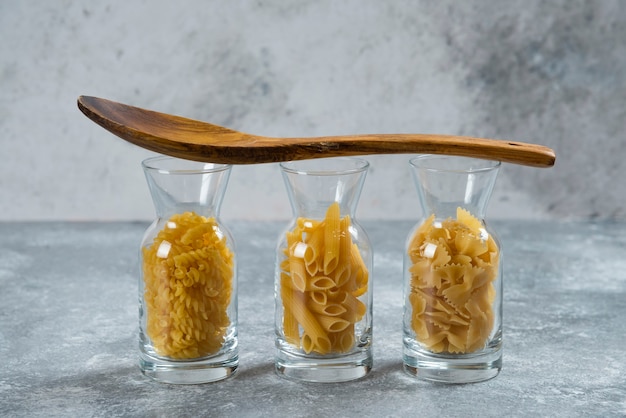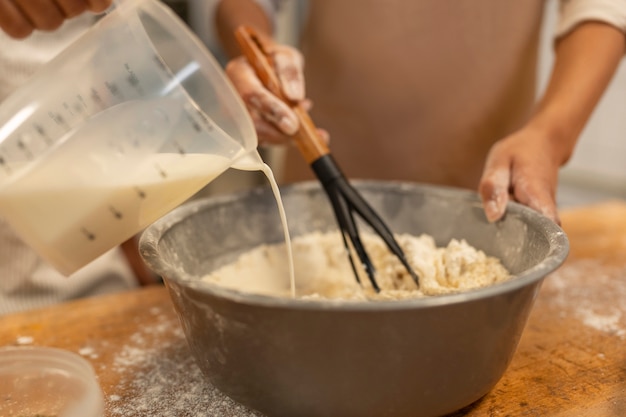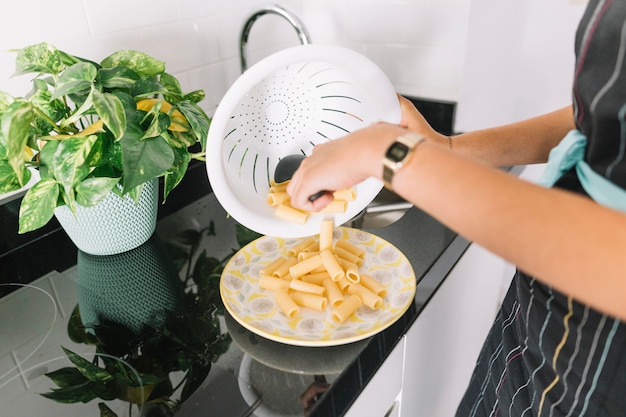Let’s be honest, glass noodles can be a bit intimidating. They’re those delicate, translucent strands that seem to vanish into thin air when you try to cook them. But fear not, fellow foodies! I've been there, battling with these slippery noodles, wondering if they'd ever cooperate. But after years of experimentation and a few epic noodle disasters, I’ve cracked the code to cooking glass noodles to perfection.
This guide is your one-stop shop for all things glass noodle. We'll explore the different types, delve into the best cooking methods, and uncover the secrets to achieving that perfect texture - the kind that's springy, translucent, and doesn't cling to everything in sight.
So, grab your chopsticks and get ready to unlock the magic of glass noodles, because this is going to be a delicious journey.
Part 1: Unveiling the World of Glass Noodles

First things first, let’s tackle the basics. What are these wondrous strands, exactly?
What Are Glass Noodles?
Contrary to their name, glass noodles are not made from glass at all. They're actually made from a combination of starches, primarily mung bean starch or potato starch, and sometimes with a bit of tapioca starch for extra texture. The process is fascinating: the starch is mixed with water, then heated and stretched into thin, delicate threads. They’re then dried, resulting in the transparent, chewy noodles we know and love.
Types of Glass Noodles: A Culinary Expedition
You might be surprised to learn that glass noodles come in a variety of shapes and sizes. Each type lends itself to different culinary applications, adding a touch of visual and textural interest to your dishes. Here's a quick rundown of the most common types:
- Thin Glass Noodles: The most common type, these are long, thin strands, perfect for stir-fries, soups, and salads. They add a subtle texture and a delicate visual appeal to your dishes.
- Thick Glass Noodles: Also known as cellophane noodles or wide glass noodles, these are thicker and broader, with a more substantial texture. They're ideal for stir-fries or cold noodle dishes where you want a bit more bite.
- Flat Glass Noodles: These are flat, ribbon-like noodles often used in cold noodle salads or stir-fries. They add a delightful visual contrast and a slightly different texture than their thin or thick counterparts.
What do Glass Noodles Taste Like?
Now, you might be wondering, what do these noodles actually taste like? Well, they have a subtle, slightly sweet taste that doesn't really overpower any other flavours in your dish. Think of them as a blank canvas, ready to absorb the flavours of your sauce and other ingredients. They're versatile and adaptable, allowing the true stars of your dish to shine through.
Part 2: The Art of Prepping Glass Noodles

Now that we’ve covered the basics, let’s dive into the art of prepping glass noodles. This is where it gets interesting, so pay attention!
Soaking: The Secret to Success
The secret to perfect glass noodles lies in the soaking process. Before you even think about cooking, you need to soak your noodles in cold water for at least 30 minutes, and preferably up to an hour. This rehydrates the noodles, giving them back their springy texture and preventing them from becoming overly sticky.
The Delicate Dance of Soaking: Finding the Sweet Spot
Remember, soaking is a delicate dance. Over-soaking can make your noodles too soft and mushy, losing their characteristic springiness. Keep a close eye on them, and you'll find that sweet spot where they are pliable but still retain a bit of firmness.
Drain Thoroughly: The Key to Preventing a Watery Dish
Once your noodles are properly soaked, drain them thoroughly. The key here is to get rid of excess water, which can lead to a watery dish. The less water, the more the noodles can absorb the flavours of your sauce and other ingredients.
Part 3: Mastering the Art of Cooking Glass Noodles

Alright, it’s time for the main event: cooking your glass noodles! I've tried many different techniques over the years, and I've found that some methods work better than others.
Boiling: A Classic Technique
Boiling is the most common way to cook glass noodles. It's a simple and straightforward method that yields perfectly cooked noodles if you follow these steps:
- Fill a large pot with water and bring it to a rolling boil. The water should be boiling vigorously to ensure even cooking.
- Gently add the soaked noodles to the boiling water. Avoid overcrowding the pot, as this can slow down the cooking process and make your noodles clump together.
- Cook for just 2-3 minutes, or until the noodles are translucent and just slightly softened. They should still have a bit of a bite to them. Overcooking will make them mushy, so keep a close eye on the timer.
- Drain the noodles immediately in a colander. This will stop the cooking process and prevent them from overcooking.
- Run cold water over the noodles to stop the cooking process and prevent them from sticking together. This also helps to refresh them and maintain their springy texture.
Stir-frying: A Quick and Easy Option
For a quick and easy method, try stir-frying your noodles. It's a fantastic way to add extra flavour and texture to your dish:
- Heat a wok or large skillet over medium heat. The pan should be hot enough to sear the noodles slightly without burning them.
- Add a small amount of oil, just enough to lightly coat the pan. Too much oil can make the noodles greasy.
- Add your soaked glass noodles to the pan and stir-fry for 1-2 minutes, until they are heated through and just slightly softened. You want to maintain that slight springiness, so don't overcook them.
- You can add your favourite stir-fry ingredients during the last few minutes of cooking. This allows the vegetables and protein to cook without overcooking the noodles.
Soup-Making: A Delicate Touch
Glass noodles are wonderful in soups! They add a light and delicate texture that complements the broth perfectly.
- Add the soaked noodles to your soup during the last 5-10 minutes of cooking. This ensures they don't overcook and become mushy.
- Gently stir the noodles into the soup to prevent them from clumping together.
Part 4: Tips for Cooking Perfect Glass Noodles
Alright, let’s talk about the art of perfecting glass noodles. This section is all about mastering the little details that make all the difference.
The Right Ratio: Finding Balance
When cooking glass noodles, remember that they absorb a lot of liquid. Use enough water or broth to cover the noodles completely, but don’t overdo it. The goal is to ensure even cooking without creating a watery dish.
Avoiding Clumps: A Symphony of Texture
One of the most common pitfalls with glass noodles is clumping. To prevent this, you can use a few tricks:
- Stir: Stir your noodles constantly while they’re cooking, especially during the first few minutes. This prevents them from sticking together and ensures even cooking.
- Separate: After draining, use a fork or chopsticks to gently separate any clumps that may have formed. This helps to maintain the individual strands and create a visually appealing dish.
- Coat: Toss your cooked noodles in a small amount of oil or sauce. This helps to prevent them from sticking together and adds extra flavour.
Balancing Texture: Finding the Perfect Bite
The secret to perfect glass noodles is finding that sweet spot between springy and chewy. You want them to be tender but not mushy. To achieve this:
- Don't Overcook: Cook them for a shorter period of time if you prefer a firmer texture. This will ensure they maintain their signature bite.
- Cold Water Rinse: Immediately after cooking, rinse your noodles with cold water to stop the cooking process and maintain that perfect texture. This also helps to prevent them from becoming sticky.
Part 5: Storage and Shelf Life: Preserving Your Noodles
Now, let’s talk about storing those precious noodles. I’ve learned the hard way that proper storage can make a world of difference.
Storing Dry Glass Noodles: A Long-Term Approach
For dry noodles, simply keep them in their original packaging in a cool, dark, and dry place. They should last for several months. Keep them away from moisture and direct sunlight, which can affect their quality.
Storing Soaked Glass Noodles: A Short-Term Solution
Once you’ve soaked your noodles, it’s best to use them right away. But if you need to store them for later, here’s what you can do:
- Refrigerate: Place your soaked noodles in a sealed container and refrigerate for up to 24 hours. This will help to preserve their texture and prevent them from drying out.
- Rinse: Before using refrigerated noodles, give them a quick rinse with cold water to refresh them and ensure they're ready to cook. This will help to restore their springiness and remove any excess moisture that may have accumulated during storage.
Part 6: Glass Noodles in Recipes: Unleashing Culinary Creativity
Alright, let’s get into the fun stuff: using those amazing glass noodles in your recipes.
Stir-fries: A Classic Pairing
These noodles are a natural fit for stir-fries, adding a light and delicate texture to your favourite dishes. Think:
- Spicy Beef and Glass Noodles: tender beef, crisp vegetables, and a fiery chilli sauce, all served over a bed of springy glass noodles. The combination of textures and flavours creates a truly satisfying dish.
- Chicken and broccoli stir-fry: A classic for a reason! This dish features juicy chicken, crunchy broccoli, and a sweet and tangy sauce. The glass noodles add a touch of lightness and elegance to this classic dish.
Soups: Adding Depth and Delicacy
Glass noodles are a delightful addition to soups, adding a subtle taste and a delicate texture. Try these:
- chicken noodle soup: A comforting classic, elevated with the addition of glass noodles. The noodles add a lightness and a subtle flavour that complements the chicken broth perfectly.
- Tom Yum Soup: This spicy and tangy Thai soup is made even more delicious with the addition of glass noodles. The noodles add a touch of texture and a delicate contrast to the bold flavours of the soup.
Salads: A Refreshing Twist
These noodles are a refreshing addition to cold salads. They offer a fun and different texture that pairs well with a variety of flavours.
- Vietnamese Noodle Salad: This refreshing salad features fresh herbs, crisp vegetables, and a tangy nuoc cham dressing. The glass noodles add a delightful lightness and a contrasting texture to the salad.
- Asian chicken salad: tender chicken, crunchy vegetables, and a creamy dressing are all brought together by a bed of glass noodles. The noodles provide a refreshing counterpoint to the rich flavours of the salad.
Part 7: Beyond the Basics: Expanding Your Culinary Horizons
Okay, so we’ve covered the fundamentals, but there’s always more to learn. Let’s explore some fun and creative ways to use glass noodles.
Beyond Asian Cuisine: A culinary adventure
Think outside the box! Glass noodles can add a unique twist to all sorts of dishes. Here are a few ideas:
- Pasta Salads: Swap traditional pasta for glass noodles in your next pasta salad. The noodles add a lightness and a delicate texture that complements the flavours of the salad.
- Cold Noodle Dishes: Their delicate texture makes them perfect for chilled noodle dishes, especially in the summer months. They can be tossed with a variety of sauces and toppings for a refreshing and light meal.
- Wraps and Rolls: Try using glass noodles as a filling for spring rolls or wraps. They add a unique texture and a subtle flavour to these popular dishes.
Experiment with Flavours: A World of Possibilities
Don’t be afraid to experiment with different flavours! These noodles can be dressed up with a variety of sauces, marinades, and seasonings.
- Spicy Sesame Sauce: A classic combination of sesame oil, soy sauce, and chilli. The sauce adds a delightful balance of savoury, sweet, and spicy flavours.
- Sweet and Sour Sauce: A tangy and delicious sauce that adds a burst of flavour. The sweetness of the sauce complements the subtle flavour of the noodles perfectly.
- Peanut Sauce: Creamy and nutty, peanut sauce is a perfect complement to glass noodles. The sauce adds a richness and a satisfying texture that contrasts beautifully with the delicate noodles.
Add Some Crunch: Elevating Texture
Add some texture to your dishes by incorporating crunchy ingredients.
- Nuts and Seeds: Toasted sesame seeds, peanuts, or cashews add a delightful crunch. The nuts and seeds provide a satisfying textural contrast to the soft noodles.
- Crispy Vegetables: Try adding crispy fried onions, garlic chips, or roasted peppers for extra texture. The crispy vegetables add a welcome crunch and a unique flavour to the dish.
Part 8: FAQs: Demystifying Glass Noodles
I’ve gathered some of the most common questions I get about glass noodles. Let's get them answered once and for all!
1. Are Glass Noodles Gluten-Free?
Yes, glass noodles are generally gluten-free, as they are made from mung bean starch or potato starch. However, it's always a good idea to check the ingredient list, as some brands may add gluten-containing ingredients.
2. Can You Reheat Glass Noodles?
You can reheat glass noodles, but it's best to do so gently. Reheating them in the microwave can make them mushy, so it's best to use a skillet or a pot on the stovetop. Add a little oil or broth to prevent sticking.
3. How Long Do Glass Noodles Last?
Uncooked glass noodles can last for several months if stored properly in a cool, dry place. Once soaked, it's best to use them within 24 hours.
4. Can You Freeze Glass Noodles?
It's not recommended to freeze glass noodles. Freezing can affect their texture, making them mushy.
5. Can You Eat Glass Noodles Raw?
It’s not recommended to eat glass noodles raw. While they are not technically poisonous, they can be tough and difficult to digest in their raw form. It's always best to cook them before eating.
Part 9: The Final Word: Embracing the Noodle Journey
Well, there you have it! You’ve now officially become a glass noodle guru. I’m so excited for you to explore the world of these delicious and versatile noodles. So go forth and create some amazing dishes!
Remember, cooking is a journey. Don't be afraid to experiment, try new things, and most importantly, have fun!
Everyone is watching

Perfect Rice Every Time: The Ultimate Guide to Cooking Rice
Cooking TipsAs a self-proclaimed foodie, I've always been a bit obsessed with rice. It's the foundation of countless cuisi...

The Ultimate Guide to Cooking Asparagus: Tips, Techniques, and Recipes
Cooking TipsAsparagus. The mere mention of this spring delicacy conjures up images of vibrant green spears, crisp and burs...

Ultimate Guide to Cooking the Perfect Thanksgiving Turkey
Cooking TipsThanksgiving. Just the word conjures up images of overflowing tables laden with delicious food, the scent of r...

Prime Rib Roast Cooking Time Chart: Per Pound Guide
Cooking TipsPrime rib roast. Just the name conjures images of lavish dinners, crackling fires, and hearty laughter. It’s ...

Can You Cook Spaghetti with Gasoline? (The Shocking Truth)
Cooking TipsWe've all seen those crazy internet trends. You know, the ones that make you wonder, "Did someone actually try...
